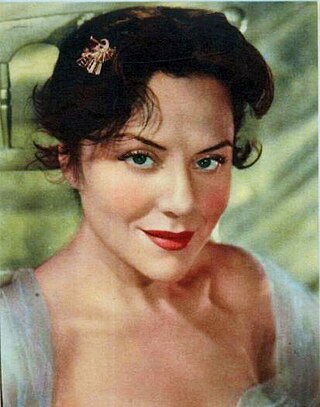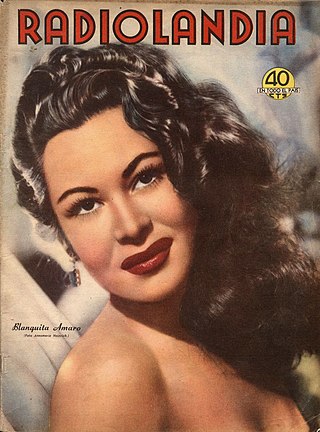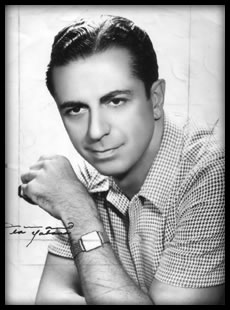Related Research Articles

María Elena Walsh was an Argentine poet, novelist, musician, playwright, writer and composer, mainly known for her songs and books for children. Her work includes many of the most popular children's books and songs of all time in her home country.

Cinema of Argentina refers to the film industry based in Argentina. The Argentine cinema comprises the art of film and creative movies made within the nation of Argentina or by Argentine filmmakers abroad.

Alejandro Rodríguez Álvarez, known as Alejandro Casona was a Spanish poet and playwright born in Besullo, Spain, a member of the Generation of '27. Casona received his bachelor's degree in Gijon and later studied at the University of Murcia. After Franco's rise in 1936, he was forced, like many Spanish intellectuals, to leave Spain. He lived in Buenos Aires, Argentina until April 1962, when he definitively returned to Spain.

Amelia Bence was an Argentine film actress and one of the divas of the Golden Age of Argentine Cinema (1940–60).

Mecha Ortiz was a classic Argentine actress who appeared in film between 1937 and 1981, during the Golden Age of Argentine Cinema. At the 1944 Argentine Film Critics Association Awards, Ortiz won the Silver Condor Award for Best Actress for her performance in Safo, historia de una pasión (1943) and won it again in 1946 for her performance in El canto del cisne (1945). She was known as the Argentine Greta Garbo and for playing mysterious characters, who suffered by past misfortunes in love, mental disorders, or forbidden love. Safo, historia de una pasión was the first erotic Argentine film, though there was no nudity. She also played in the first film in which a woman struck a man and the first film with a lesbian romance. In 1981, she was awarded the Grand Prize for actresses from the National Endowment for the Arts.

Laura Ana "Tita" Merello was an Argentine film actress, tango dancer and singer of the Golden Age of Argentine Cinema (1940–1960). In her 6 decades in Argentine entertainment, at the time of her death, she had filmed over thirty movies, premiered twenty plays, had nine television appearances, completed three radio series and had had countless appearances in print media. She was one of the singers who emerged in the 1920s along with Azucena Maizani, Libertad Lamarque, Ada Falcón, and Rosita Quiroga, who created the female voices of tango. She was primarily remembered for the songs "Se dice de mí" and "La milonga y yo".

Enrique Cahen Salaberry was a prolific Argentine film director whose career in the Cinema of Argentina as a movie director spanned five decades.
Carlos Torres Ríos (1898–1956) was an Argentine cinematographer, film director, screenwriter, film editor and film producer of the classic era.

Blanquita Amaro was a Cuban film actress of the 1940s and early 1950s who starred in the Golden Age of Argentine Cinema.

Manuel Romeo was an Argentine film director, screenwriter, dramatist and score composer, and one of the influential directors in the cinema of Argentina of the classic era. He directed and wrote over 50 films between 1931 and 1951 even composing the musical scores for several.

Roque Funes was the most prolific Argentine cinematographer in the history of the Cinema of Argentina whose career spanned over 40 years of cinema.

Fernando Siro was an Argentine film actor, film director and screenwriter.

Juan Carlos Thorry, born José Antonio Torrontegui, was an Argentine film actor, tango musician and director.

The Path to Crime is a 1951 Argentine comedy film directed by Don Napy.

Zulema Esther González Borbón, better known as Zully Moreno, was an Argentine film actress of the Golden Age of Argentine Cinema (1940–1960). She appeared in more than 70 movies, earning best actress awards from the Argentine Academy of Motion Picture Arts and Sciences and the Spanish Cinema Writers Circle.

Enrique Serrano (1891–1965) was an Argentine actor and comedian in the 1940s and 1950s.
The Arequito revolt, was a military revolt by officers of the Army of the North through which they recused themselves from the fight in the civil war against the federales. Their intention was to return to the front of the war against the royalists in Upper Peru, an objective that they could not ultimately meet. It signified the beginning of the disintegration of the Supreme Directorship and was one of the main causes of the centralist defeat at the Battle of Cepeda.

Francisco "Paco" Madrid was a Spanish (Catalan) journalist, writer and screenwriter.

María Elena Lucena Arcuri was an Argentine film actress of the Golden Age of Argentine Cinema (1940–60). She began her career in radio in the 1930s and reached her greatest success with the role of "Chimbela", which was later depicted in film, theater and television. Her extensive film career includes approximately 50 films, including notable performances in Chimbela (1939) and Una noche cualquiera (1951). During the 1940s, she participated in films with comedians like Pepe Arias, Pepe Iglesias "El Zorro", Niní Gambier, Mirtha Legrand and Carlos Estrada. Her most acclaimed film work occurred in Elvira Fernández, vendedora de tienda (1942) by Manuel Romero, Cinco besos by Luis Saslavsky and La Rubia Mireya for which she received the 1948 Best Comedy Actress Award from the Argentine Film Critics Association.

Estudios San Miguel was an Argentine film studio that was active in the 1940s and early 1950s. It flourished during the golden age of Cinema of Argentina, and at its peak was one of the major studios in Buenos Aires. Genres ranged from musical comedy to costume drama and gaucho thriller. Films included La guerra gaucha, co-produced with Artistas Argentinos Asociados, and the comedy Juvenilia (1943), both of which won several major awards. Eva Duarte, soon to become the first lady of Argentina as Eva Perón, appeared in two of the studio's films in 1945. The studio became overextended financially and ceased production after 1952.
References
- ↑ Elena & Lopez p.169
- ↑ "Buenos Aires en relieve - Primera película Argentina en 3D estrenada en 1954, de Don Napy". YouTube .